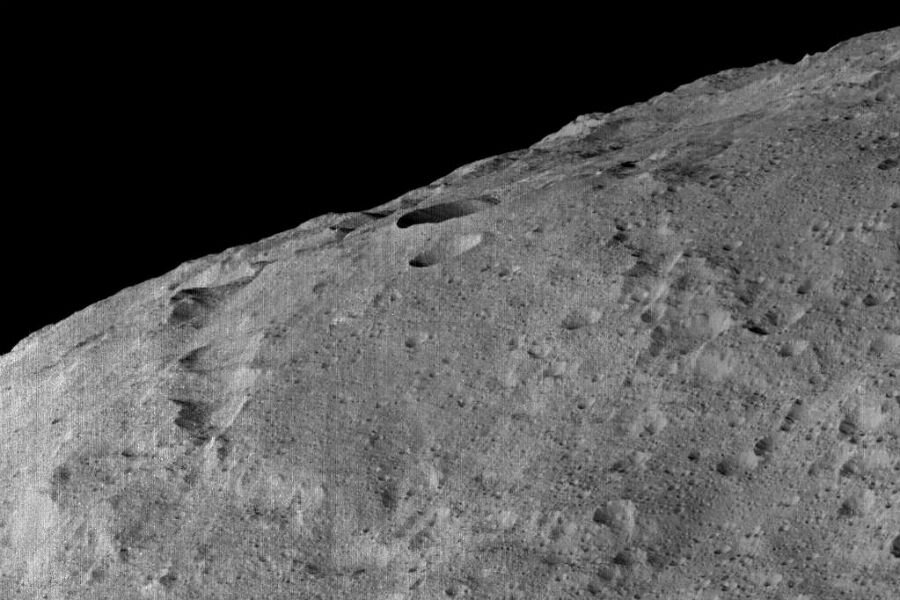Dwarf planet Ceres has organic molecules, widening the hunt for life
Loading...
Life, or at least its basic chemical parts, might actually be all around us.
NASA’s Dawn spacecraft has discovered organic molecules on Ceres, according to a paper published in the journal Science on Friday. These so-called “building blocks of life” appear to be native, forming naturally on the dwarf planet rather than being deposited by comets.
The find adds to a growing understanding that these compounds exist all over the solar system, from comets to the moons of Jupiter, widening the scope of our hunt for microscopic life.
“[Ceres] joins Mars and several satellites of the giant planets in the list of locations in the solar system that may harbor life,” the European Space Agency’s Michael Küppers, who was not involved in the study, wrote in a commentary.
Fittingly named after the Roman goddess of agriculture and fertility, Ceres orbits the sun amidst the asteroids that make up the rocky belt between Mars and Jupiter. The tiny world, just over 1 percent the mass of our moon, ranks with Pluto as one of the solar system’s five known dwarf planets.
Dawn’s decade-long odyssey brought it to fellow asteroid belt denizen Vesta, before finally settling into orbit around Ceres in 2015, making it the first spacecraft to orbit two extraterrestrial bodies.
During its short two years circling Ceres, Dawn has radioed discovery after discovery back to Earth. First it was mysterious bright spots, now thought to be a type of salt deposit; then it was ice volcanoes indicating possible subsurface ice. Now, it’s the detection of the carbon-rich molecules thought to be a prerequisite to life.
“We were not expecting to see something like this on the surface of Ceres,” study coauthor Christopher Russell, a planetary scientist at the University of California, Los Angeles, and Dawn’s principal investigator, told The Los Angeles Times. The simple materials are “really pre-biological, but they’re in the family of materials that we would expect if Ceres was working its way along the complexity path,” he said.
Dawn spotted the carbon compounds with its onboard spectrometer, which analyzes the various types of light waves it picks up. Our own eyes act like little spectrometers in a way. Grass looks green to us because it reflects a lot of green light and absorbs most other colors, something we can detect even without direct contact. Similarly, Dawn’s digital eyes let it make deductions about the surface’s makeup even without getting close enough for a taste.
The team spotted the organic material scattered over an area comparable to the size of the five boroughs of New York City. Concentrated on the boundary of a 30-mile-wide crater called Ernutet, the stuff could be a tar-like substance such as asphaltite, according to Space.com.
Many scientists suspect comets delivered similar building blocks to early Earth, but that doesn’t seem to be the case on Ceres. The material’s distribution doesn’t match that scenario, and researchers don’t expect these organics would have survived the intensity of an impact.
The precise mechanism that created the carbon molecules remains a mystery, but some speculate they could have sprung from underground warm-water activity.
"Because Ceres is a dwarf planet that may still preserve internal heat from its formation period and may even contain a subsurface ocean, this opens the possibility that primitive life could have developed on Ceres itself," wrote Dr. Küppers.
In recent years scientists have learned that space in general, and our solar system in particular, are made up of much more than inert dust and gas. In the last year alone, teams have found signs of the RNA component Ribose and amino acid glycine on comets, as well as “prebiotic conditions” in the frigid methane tidal pools of Titan. Some scientists have asked whether organic material might be the rule, rather than the exception.
While signs of life are all around us, the ultimate prize proves elusive. Detecting conclusive proof of life turns out to be a tough task for autonomous rovers, as demonstrated by continued debate over the Viking findings from the 1970's.
Nevertheless, NASA is hard at work developing new technologies that are up to the challenge. In the meantime, some are placing their bets not on if life will be found, but where.








